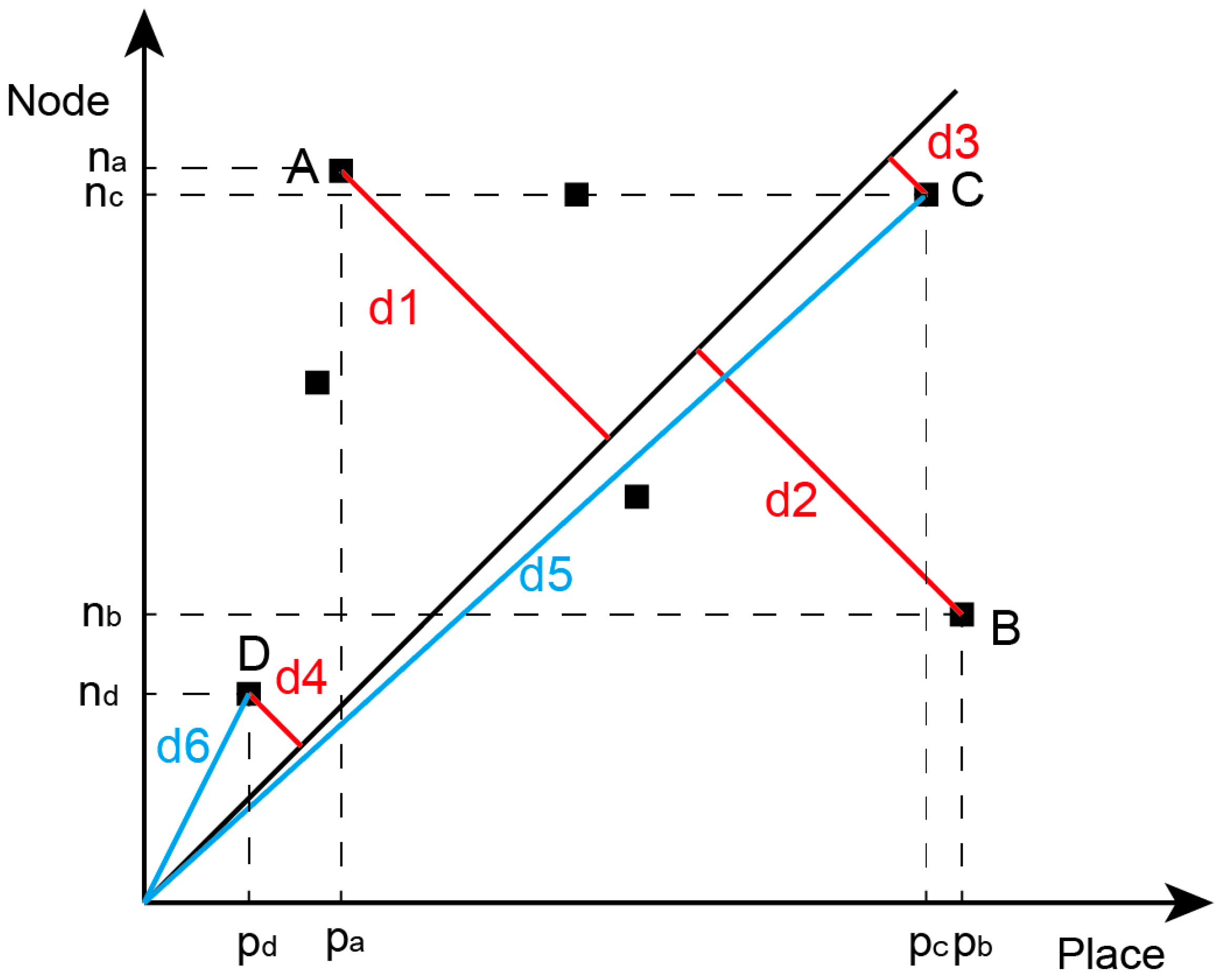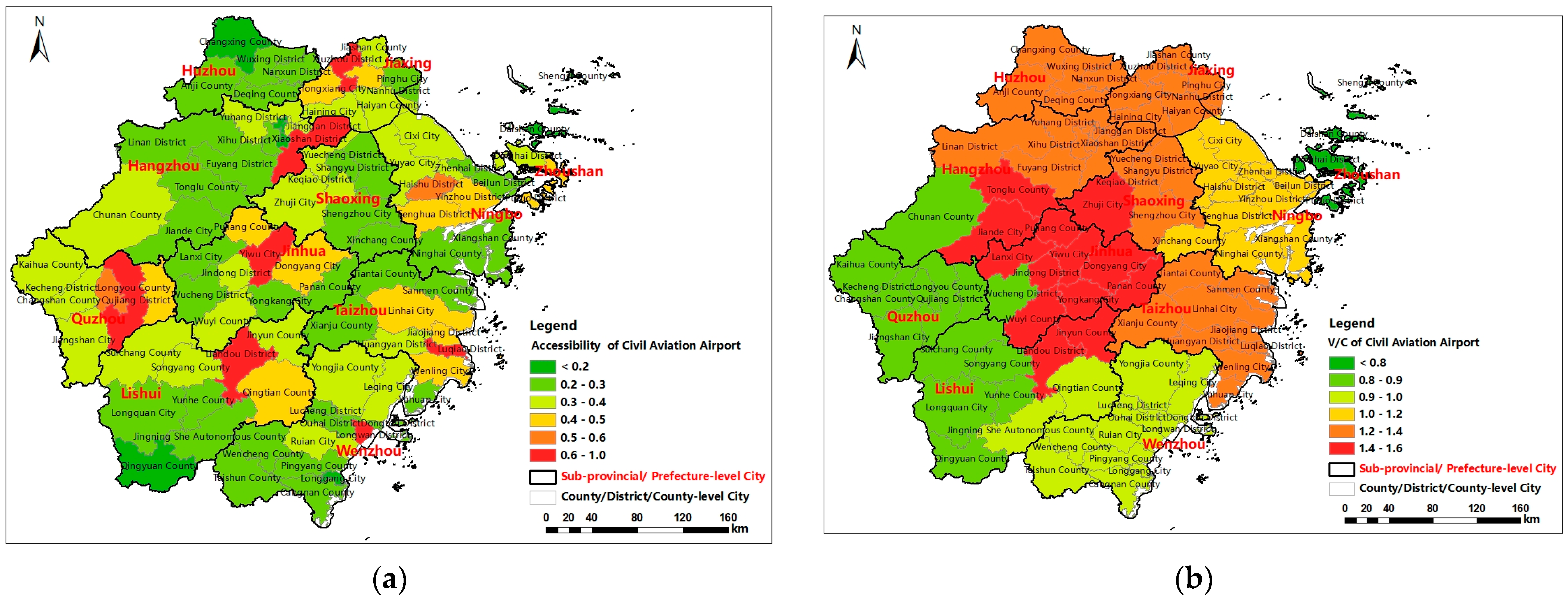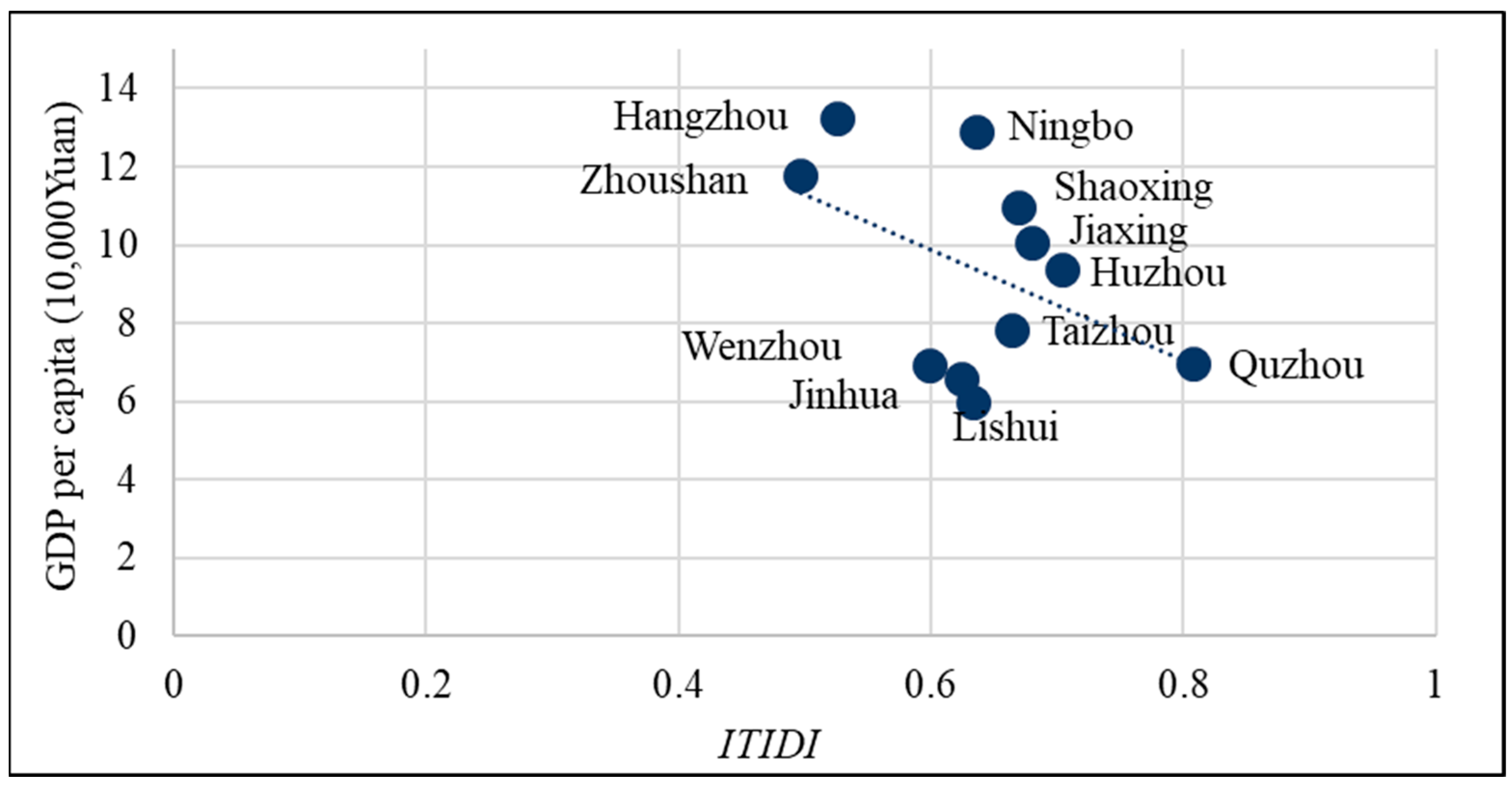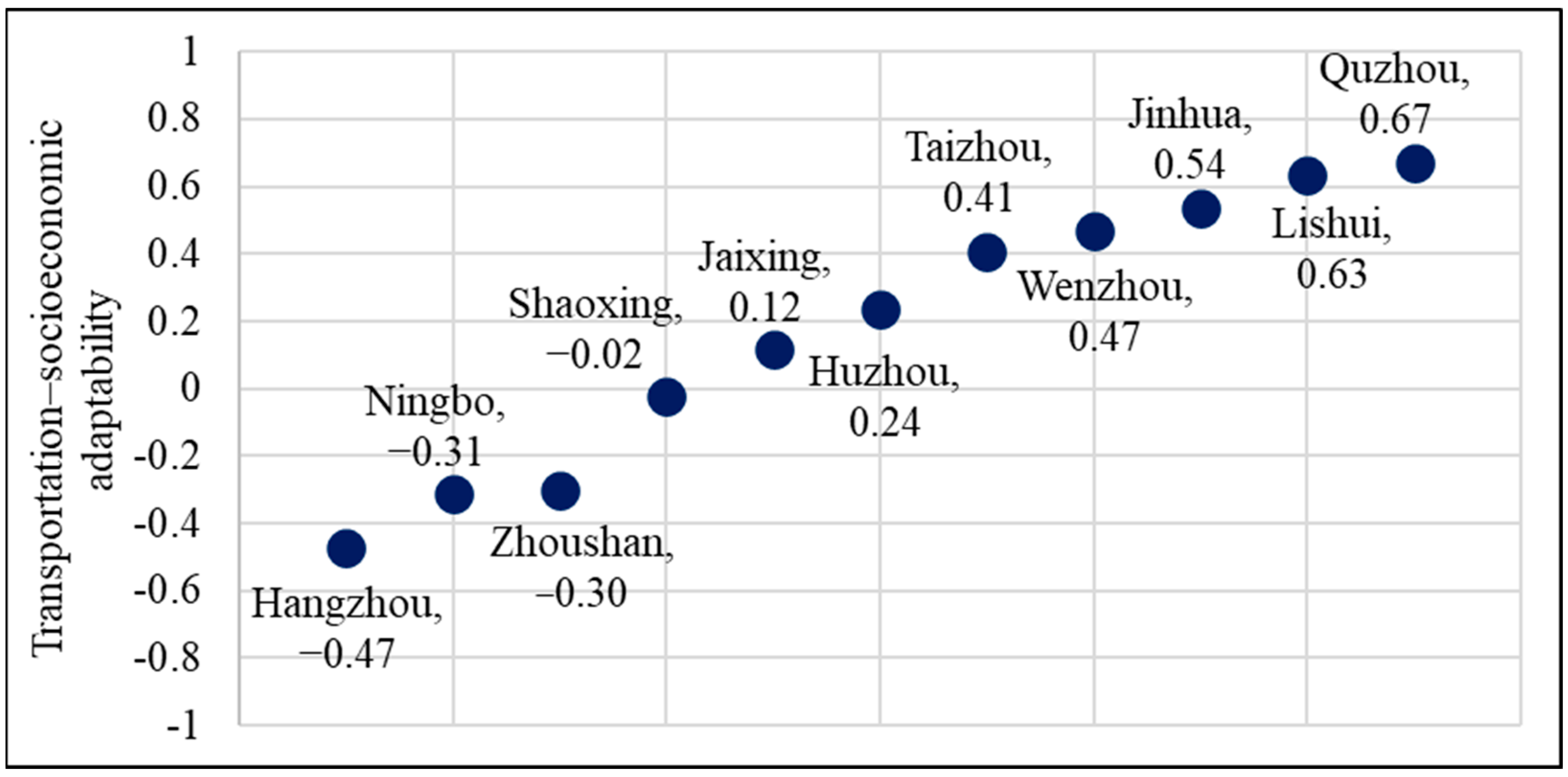Unveiling Transportation Socio-Economic Adaptability Using a Node–Place Model: A Case from Zhejiang Province, China
Abstract
:1. Introduction
2. Data and Methodology
2.1. Research Areas
2.2. Data and Resources
2.3. Methodology
2.3.1. The NP Model and the Modification
2.3.2. Transportation Infrastructure Indicators
2.3.3. Socioeconomic Indicators
3. Results
3.1. Transportation Infrastructures in Zhejiang, China
3.1.1. Railway
3.1.2. Freeways
3.1.3. Civil Aviation Airports
3.2. Transportation Socioeconomic Adaptability
4. Discussion
5. Conclusions
Author Contributions
Funding
Institutional Review Board Statement
Informed Consent Statement
Data Availability Statement
Conflicts of Interest
References
- Zhu, Z.; Zhang, X.; Xue, M.; Song, Y. Eco-Efficiency and Its Evolutionary Change under Regulatory Constraints: A Case Study of Chinese Transportation Industry. Sustainability 2023, 15, 7381. [Google Scholar] [CrossRef]
- Wang, Y.; Zhou, Y.; Zhu, L.; Zhang, F.; Zhang, Y. Influencing Factors and Decoupling Elasticity of China’s Transportation Carbon Emissions. Energies 2018, 11, 1157. [Google Scholar] [CrossRef]
- Tong, Q.; Zhang, L.; Liu, J. Transportation Infrastructure and Common Prosperity from the Perspective of Chinese-Style Modernization: Enabling Effects and Advancement Paths. Sustainability 2024, 16, 1677. [Google Scholar] [CrossRef]
- Zhao, B.; Wang, N.; Wang, Y. The Role of Different Transportation Modes in China’s National Economy: An Input–Output Analysis. Transp. Policy 2022, 127, 92–102. [Google Scholar] [CrossRef]
- Glaeser, E.L.; Ponzetto, G.A.M. The Political Economy of Transportation Investment. Econ. Transp. 2018, 13, 4–26. [Google Scholar] [CrossRef]
- Chanieabate, M.; He, H.; Guo, C.; Abrahamgeremew, B.; Huang, Y. Examining the Relationship between Transportation Infrastructure, Urbanization Level and Rural-Urban Income Gap in China. Sustainability 2023, 15, 8410. [Google Scholar] [CrossRef]
- Jiang, X.; He, X.; Zhang, L.; Qin, H.; Shao, F. Multimodal Transportation Infrastructure Investment and Regional Economic Development: A Structural Equation Modeling Empirical Analysis in China from 1986 to 2011. Transp. Policy 2017, 54, 43–52. [Google Scholar] [CrossRef]
- Mwale, M.; Luke, R.; Pisa, N. Factors That Affect Travel Behaviour in Developing Cities: A Methodological Review. Transp. Res. Interdiscip. Perspect. 2022, 16, 100683. [Google Scholar] [CrossRef]
- Ali, R.; Bakhsh, K.; Yasin, M.A. Causal Nexus between Air Transportation and Economic Growth in BRICS Countries. J. Air Transp. Manag. 2023, 107, 102335. [Google Scholar] [CrossRef]
- National Bureau of Statistics of China. Statistical Bulletin on National Economic and Social Development of the People’s Republic of China in 2019; National Bureau of Statistics of China: Beijing, China, 2020. [Google Scholar]
- Zhao, B.; Wu, H.; Wang, N. Changing Characteristics of the Industrial Correlation and Economic Contribution of Air Transport in China: An Input–Output Analysis. J. Air Transp. Manag. 2022, 104, 102275. [Google Scholar] [CrossRef]
- Baldwin, R.E.; Martin, P. Agglomeration and Regional Growth. In Handbook of Regional and Urban Economics; North-Holland: Amsterdam, The Netherlands, 2004; Volume 4, pp. 2671–2711. ISBN 9780444509673. [Google Scholar]
- Holtz-Eakin, D.; Schwartz, A.E. Spatial Productivity Spillovers from Public Infrastructure: Evidence from State Highways. Int. Tax Public Financ. 1995, 2, 459–468. [Google Scholar] [CrossRef]
- Gallen, T.S.; Winston, C. Transportation Capital and Its Effects on the U.S. Economy: A General Equilibrium Approach. J. Macroecon. 2021, 69, 103334. [Google Scholar] [CrossRef]
- Kasu, B.B.; Chi, G. Transportation Infrastructures and Socioeconomic Statuses: A Spatial Regression Analysis at the County Level in the Continental United States, 1970–2010. Spat. Demogr. 2019, 7, 27–56. [Google Scholar] [CrossRef] [PubMed]
- Pradhan, R.P.; Arvin, M.B.; Nair, M. Urbanization, Transportation Infrastructure, ICT, and Economic Growth: A Temporal Causal Analysis. Cities 2021, 115, 103213. [Google Scholar] [CrossRef]
- Agbelie, B.R.D.K. An Empirical Analysis of Three Econometric Frameworks for Evaluating Economic Impacts of Transportation Infrastructure Expenditures across Countries. Transp. Policy 2014, 35, 304–310. [Google Scholar] [CrossRef]
- He, D.; Yin, Q.; Zheng, M.; Gao, P. Transport and Regional Economic Integration: Evidence from the Chang-Zhu-Tan Region in China. Transp. Policy 2019, 79, 193–203. [Google Scholar] [CrossRef]
- Ding, C. Transport Development, Regional Concentration and Economic Growth. Urban Stud. 2013, 50, 312–328. [Google Scholar] [CrossRef]
- Zhang, Y.; Cheng, L. The Role of Transport Infrastructure in Economic Growth: Empirical Evidence in the UK. Transp. Policy 2023, 133, 223–233. [Google Scholar] [CrossRef]
- Saidi, S.; Hammami, S. Modeling the Causal Linkages between Transport, Economic Growth and Environmental Degradation for 75 Countries. Transp. Res. Part D Transp. Environ. 2017, 53, 415–427. [Google Scholar] [CrossRef]
- Shen, S.; Li, H.; Li, M. Transportation Infrastructure and Digital Economy—Evidence from Chinese Cities. Sustainability 2023, 15, 16024. [Google Scholar] [CrossRef]
- Tan, R.; Pan, L.; Xu, M.; He, X. Transportation Infrastructure, Economic Agglomeration and Non-Linearities of Green Total Factor Productivity Growth in China: Evidence from Partially Linear Functional Coefficient Model. Transp. Policy 2022, 129, 1–13. [Google Scholar] [CrossRef]
- Wang, F.; Liu, Z.; Xue, P.; Dang, A. High-Speed Railway Development and Its Impact on Urban Economy and Population: A Case Study of Nine Provinces along the Yellow River, China. Sustain. Cities Soc. 2022, 87, 104172. [Google Scholar] [CrossRef]
- Xu, M.I.N.G.; Feng, Y.U.A.N. How Transportation Infrastructure Affects Firm Productivity? Evidence from China. China Econ. Q. Int. 2022, 2, 55–69. [Google Scholar] [CrossRef]
- Ma, J.; Zhao, Y. Study on the Adaptability of the Level of Urban Transportation Infrastructure and Economic Development. Appl. Mech. Mater. 2013, 361–363, 1950–1953. [Google Scholar] [CrossRef]
- Li, Q.; Zhan, B.; Zhang, Q.B. The Analysis of Feasibility between Waterway Transportation and Economy of Hubei Province Based on DEA Model. Adv. Mater. Res. 2013, 694–697, 3333–3335. [Google Scholar] [CrossRef]
- He, H.; Luo, W. The Adaptability Research of Regional Airports and County Economy Based on PCA—Taking Sichuan as an Example. In Proceedings of the CICTP 2021, Reston, VA, USA, 14 December 2021; American Society of Civil Engineers: Reston, VA, USA; pp. 1934–1942. [Google Scholar]
- He, H.; Han, Z.; He, X.; Wang, S. The Analysis of Socioeconomic Adaptability of China’ s Civil Aviation Development. IOP Conf. Ser. Earth Environ. Sci. 2020, 587, 012111. [Google Scholar] [CrossRef]
- Bertolini, L. Spatial Development Patterns and Public Transport: The Application of an Analytical Model in the Netherlands. Plan. Pract. Res. 1999, 14, 199–210. [Google Scholar] [CrossRef]
- Vale, D.S. Transit-Oriented Development, Integration of Land Use and Transport, and Pedestrian Accessibility: Combining Node-Place Model with Pedestrian Shed Ratio to Evaluate and Classify Station Areas in Lisbon. J. Transp. Geogr. 2015, 45, 70–80. [Google Scholar] [CrossRef]
- Monajem, S.; Ekram Nosratian, F. The Evaluation of the Spatial Integration of Station Areas via the Node Place Model; an Application to Subway Station Areas in Tehran. Transp. Res. Part D Transp. Environ. 2015, 40, 14–27. [Google Scholar] [CrossRef]
- Olaru, D.; Moncrieff, S.; McCarney, G.; Sun, Y.; Reed, T.; Pattison, C.; Smith, B.; Biermann, S. Place vs. Node Transit: Planning Policies Revisited. Sustainability 2019, 11, 477. [Google Scholar] [CrossRef]
- Reusser, D.E.; Loukopoulos, P.; Stauffacher, M.; Scholz, R.W. Classifying Railway Stations for Sustainable Transitions—Balancing Node and Place Functions. J. Transp. Geogr. 2008, 16, 191–202. [Google Scholar] [CrossRef]
- Zemp, S.; Stauffacher, M.; Lang, D.J.; Scholz, R.W. Classifying Railway Stations for Strategic Transport and Land Use Planning: Context Matters! J. Transp. Geogr. 2011, 19, 670–679. [Google Scholar] [CrossRef]
- Liu, S.; Rong, J.; Zhou, C.; Bian, Y. Probability -Based Typology for Description of Built Environments around Urban Rail Stations. Build. Environ. 2021, 205, 108193. [Google Scholar] [CrossRef]












| City | Accessibility | Capacity Utilization | ITIDI | ||||||
|---|---|---|---|---|---|---|---|---|---|
| Railway | Freeway | Civil Aviation | CA | Railway | Freeway | Civil Aviation | C-V/C | ||
| Hangzhou | 0.59 | 0.71 | 0.30 | 0.66 | 0.72 | 0.53 | 1.23 | 0.61 | 0.53 |
| Huzhou | 0.66 | 0.92 | 0.20 | 0.88 | 0.75 | 0.41 | 1.22 | 0.47 | 0.70 |
| Jiaxing | 0.60 | 0.85 | 0.22 | 0.81 | 0.75 | 0.38 | 1.22 | 0.45 | 0.68 |
| Jinhua | 0.59 | 0.70 | 0.42 | 0.69 | 0.69 | 0.40 | 1.45 | 0.44 | 0.62 |
| Lishui | 0.68 | 0.76 | 0.22 | 0.75 | 0.38 | 0.50 | 1.12 | 0.48 | 0.63 |
| Ningbo | 0.65 | 0.85 | 0.36 | 0.76 | 0.50 | 0.44 | 1.03 | 0.49 | 0.64 |
| Quzhou | 0.75 | 0.83 | 0.47 | 0.82 | 0.80 | 0.15 | 0.81 | 0.20 | 0.81 |
| Shaoxing | 0.73 | 0.82 | 0.31 | 0.80 | 0.64 | 0.42 | 1.28 | 0.46 | 0.67 |
| Taizhou | 0.61 | 0.76 | 0.41 | 0.75 | 0.43 | 0.42 | 1.38 | 0.42 | 0.66 |
| Wenzhou | 0.56 | 0.74 | 0.30 | 0.73 | 0.41 | 0.53 | 0.95 | 0.53 | 0.60 |
| Zhoushan | 0.21 | 0.44 | 0.31 | 0.41 | 0.43 | 0.41 | 0.76 | 0.42 | 0.50 |
Disclaimer/Publisher’s Note: The statements, opinions and data contained in all publications are solely those of the individual author(s) and contributor(s) and not of MDPI and/or the editor(s). MDPI and/or the editor(s) disclaim responsibility for any injury to people or property resulting from any ideas, methods, instructions or products referred to in the content. |
© 2024 by the authors. Licensee MDPI, Basel, Switzerland. This article is an open access article distributed under the terms and conditions of the Creative Commons Attribution (CC BY) license (https://creativecommons.org/licenses/by/4.0/).
Share and Cite
Shi, J.; Wang, S.; Liu, S.; Zhou, C. Unveiling Transportation Socio-Economic Adaptability Using a Node–Place Model: A Case from Zhejiang Province, China. Sustainability 2024, 16, 4009. https://doi.org/10.3390/su16104009
Shi J, Wang S, Liu S, Zhou C. Unveiling Transportation Socio-Economic Adaptability Using a Node–Place Model: A Case from Zhejiang Province, China. Sustainability. 2024; 16(10):4009. https://doi.org/10.3390/su16104009
Chicago/Turabian StyleShi, Jianwei, Shuwei Wang, Siyang Liu, and Chenjing Zhou. 2024. "Unveiling Transportation Socio-Economic Adaptability Using a Node–Place Model: A Case from Zhejiang Province, China" Sustainability 16, no. 10: 4009. https://doi.org/10.3390/su16104009





